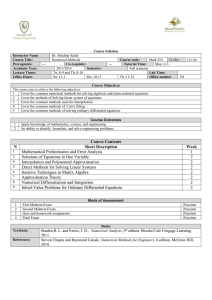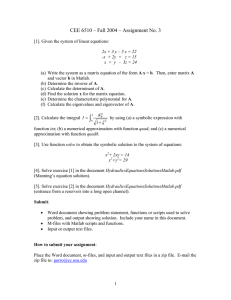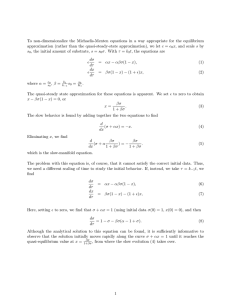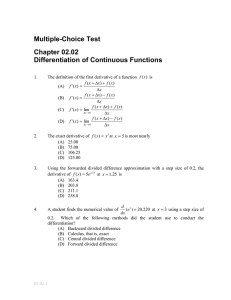comparison of the numerical solutions of transient adiabatic reactor
advertisement
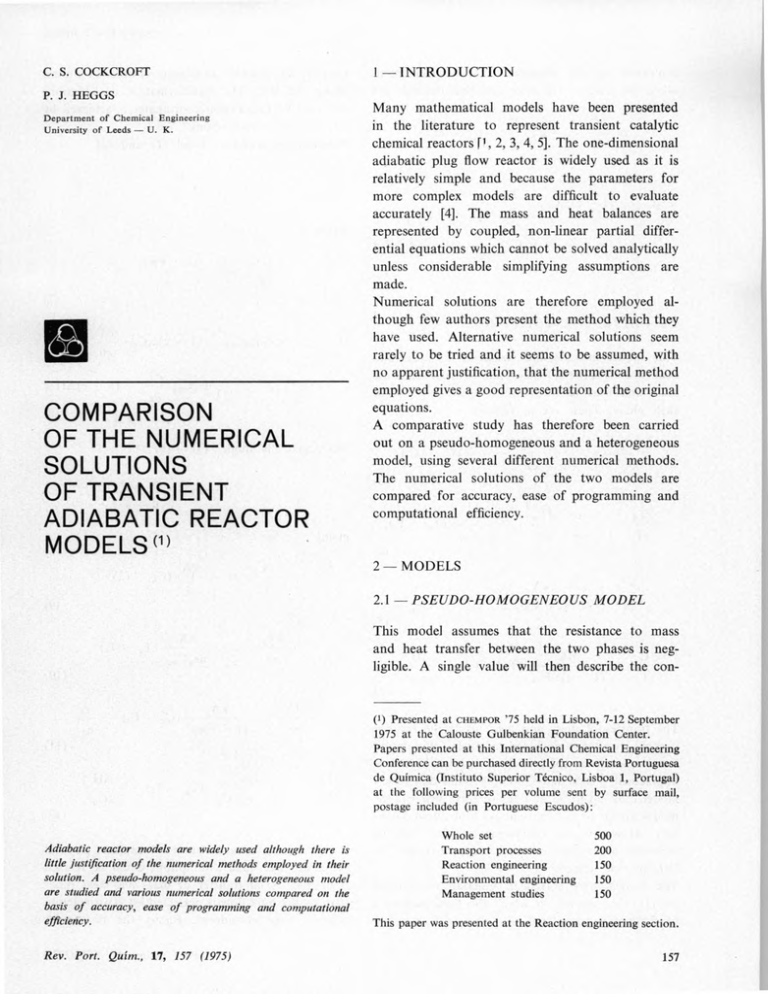
C. S. COCKCROFT
1 — INTRODUCTION
P. J. HEGGS
Department of Chemical Engineering
University of Leeds — U. K.
COMPARISON
OF THE NUMERICAL
SOLUTIONS
OF TRANSIENT
ADIABATIC REACTOR
MODELS (1)
Many mathematical models have been presented
in the literature to represent transient catalytic
chemical reactors [t, 2, 3, 4, 5]. The one-dimensional
adiabatic plug flow reactor is widely used as it is
relatively simple and because the parameters for
more complex models are difficult to evaluate
accurately [4]. The mass and heat balances are
represented by coupled, non-linear partial differential equations which cannot be solved analytically
unless considerable simplifying assumptions are
made.
Numerical solutions are therefore employed although few authors present the method which they
have used. Alternative numerical solutions seem
rarely to be tried and it seems to be assumed, with
no apparent justification, that the numerical method
employed gives a good representation of the original
equations.
A comparative study has therefore been carried
out on a pseudo-homogeneous and a heterogeneous
model, using several different numerical methods.
The numerical solutions of the two models are
compared for accuracy, ease of programming and
computational efficiency.
2 — MODELS
2.1 — PSEUDO-HOMOGENEOUS MODEL
This model assumes that the resistance to mass
and heat transfer between the two phases is negligible. A single value will then describe the con-
( 1 ) Presented at CHEMPOR '75 held in Lisbon, 7-12 September
1975 at the Calouste Gulbenkian Foundation Center.
Papers presented at this International Chemical Engineering
Conference can be purchased directly from Revista Portuguesa
de Química (Instituto Superior Técnico, Lisboa 1, Portugal)
at the following prices per volume sent by surface mail,
postage included (in Portuguese Escudos):
Adiabatic reactor models are widely used although there is
little justification of the numerical methods employed in their
solution. A pseudo-homogeneous and a heterogeneous model
are studied and various numerical solutions compared on the
basis of accuracy, ease of programming and computational
efficiency.
Rev. Port. Quím., 17, 157 (1975)
Whole set
Transport processes
Reaction engineering
Environmental engineering
Management studies
500
200
150
150
150
This paper was presented at the Reaction engineering section.
157
C. S. COCKCROFT, P. J. HEGGS
centration or the temperature at a given point
along the reactor. The mass and heat balances are
P
ac
at
ac
_
r(1 — e)
— u az
coordinates, in which an element of fluid is followed
along the bed. The transformation of equations
(1) —. (6) to Lagrangian coordinates is achieved by
the following substitutions.
Pseudo-homogeneous model (1) and (2)
(1)
(epsCps
_
zep
0—t
aT
-I- (I -- e)psCps) u
=
at
— upsCpg
giving
aT
(1 — e)AH • r
az
ac(1
(2)
az
—
—
— e)ep
r
u
(7)
2.2 — HETEROGENEOUS MODEL
(e — (1 — e)ep)psCpg + (I — e)psCps)
This model includes the resistance to mass and
heat transfer between the two phases and so separate
mass and heat balances are required to describe
each phase. These are as follows:
aC g
at
—
u
aC gkA
e
az
e
= — upsCps at
az
e
(Tg
—
(1 — e)OH•r
Heterogeneous model (3) —+ (6)
(Cs — CO
aT ghA
u
az
( 8)
(3)
aT g __
aT
aT
ao
TS)
ze
0 '=t
u
giving
epgCpg
(4)
acs
kA
at
(1 — e)ep
(Cg — CO
aC gkA
(Cs — CO
az—u
r
(9)
ep
(5)
aT ghA
aTs
hA
at
( 1 e )psCps
—
(Ts
—
TS)
AH
a z
r
upgCpg
(Ts — TO
(10)
psCps
(6)
acs _
The transfer of mass and heat inside the catalyst
particles was not included as the computation
time required to solve such models makes them
impractical. FEICK and QUON [3] found that such a
model took up to 90 minutes to solve whereas the
model similar to that in (b) above took about 5 minutes. However, an effectiveness factor can be
included in the reaction term to approximate the
intra-particle effects.
The models were solved in Eulerian coordinates
[as (1) —+ (6) above], in which the fluid passing a
fixed point is considered, and also in Lagrangian
158
00'
aTs
0 0'
kA
(Cg — CO
(1 — e)ep
hA
(1 — e)psCps
(Ts
—
Ts)
—
r
ep
11H
r
psCps
(12)
Both models assume constant velocity and physical
properties but these assumptions could be relaxed
if desired. Axial transfer of mass and heat other
than by the bulk flow is neglected [6]. Two reaction
systems were considered. Firstly the first order
Rev. Port. Quím., 17, 157 (1975)
TRANSIENT ADIABATIC REACTOR MODELS
irreversible exothermic oxidation of carbon monoxide [7] and also the reversible endothermic dehydrogenation of ethylbenzene [8]. The heat and mass
transfer coefficientes for the oxidation reaction
were taken from THORNTON [9] and for the dehydrogenation reaction they were calculated from
j — factor correlations [10].
The equations are highly non-linear, thus analytical
solutions are difficult, if at all possible, and so
numerical solutions must be sought. In order to
verify the accuracy of the numerical methods
employed, the equations were made linear by
neglecting the reaction term. This allows comparison
of the numerical results with analytical solutions
and the evaluation of the stability of numerical
techniques.
3 — NUMERICAL METHODS
3.1—METHOD OF CHARACTERISTICS [11]
This is generally the most accurate method for
hyperbolic equations such as (1) (6) above. The
characteristic directions for the system are first
evaluated along which the partial differential
equations reduce to ordinary differential ones.
These are then solved numerically along the characteristic directions at the points of intersection of
the pairs of characteristics.
For the heterogeneous model, the equation to be
solved along the characteristics are as (9) —+ (12)
above. Equations (9) and (10) are solved along
dz
u
dt
e
dt
uPgCpB
(epgCpg — (1 — e)p s Cp s )
dt
if the reaction term is ignored, the pseudo-homogeneous model gives constant temperature and
concentration along the characteristics. These then
are an analytical solution of the linear equations
showing that a step change at the inlet moves
unchanged along the bed.
3.2—FINITE DIFFERENCE APPROXIMATIONS
The domain is covered by a rectangular grid, and
the differentials are replaced by finite differences
between the intersections of the grid. This reduces
the partial differential equations to a set of algebraic
equations. Fig. 1 shows a section of the grid in
which p refers to the length direction and q refers
to the time direction.
The backward difference approximation is given
by,
Fig. 1
Section of finite difference grid
dTp,
dt
and (11) and (12) along
dz
dz
Tp,g
g
—
Tp,q — 1
At
(13)
0 .
and the forward difference approximation by
The pseudo-homogeneous equations are,
ac
atep
ôT_
at(epgCpg
along
dz
dt
(1 — e)OHr
— (1 — e)psCps)
Rev. Port. Quím., 17, 157 (1975)
dTp, q
dt
u
ep
Tp,g+I
-T p
,
q
At
(14)
along
These are both single step formulae, that is, only a
159
C. S. COCKCROFT, P. J. HEGGS
single grid increment is considered. The usual
central difference approximation
dTP,
TP, q +
q
TP,g- 1
20t
dt
is a two step formula and it is not suitable at the
ends of the bed. To overcome this problem, a
Modified Euler approximation is used. This is
dTP,
2
q
+ dTP, q-1
dt
dTP, q-
dt
quired thus makes this method impractical although
it is suitable for the linear equations [13].
The stability of the finite difference approximations
was investigated by means of the Fourier series
method [11] on the linear equations. Tne error at
grid point (p, q) is
Eq, g= eibPOz • eat = eibPOZ . Sq
where
nrc
i = ✓ -1 , b=
2
dt
TP, q - Tp,q - I
At
(15)
which is a single step formula and has been shown
[12] to have the same truncation error as the two
step formula.
and a = complex constant. The error will not
increase as t increases provided 5 1.
To illustrate the method consider the linear form
of the pseudo-homogeneous heat balance using
backward difference approximations.
T R q - T P, q - 1 =
-
Q(TP, q - T P - 1, q)
where
3.3 — METHOD OF LINES
Here the length derivative is approximated by a
finite difference formula and the resulting ordinary
differential equations are solved by a Runge-Kutta
technique. If a backward difference formula is
used, the equations are identica' to the forward
cell model [7] in which the reactor is represented by
a series of stirred tanks.
OtupgCPg
Q=
Oz(epgCPg + (1 — e)p s C Ps)
Replacing the variables by the errors (E r , q )
e ibPOz.
— e ib P Oz. ^q
—
t =
— — (eibPzO.
-
= -
Q(1 - e -ibOz)
3.4 — PREDICTOR CORRECTOR
An Euler predictor [equation (14)] and Modified
Euler corrector [equation (15)] formula was used
for the heterogeneous model in Lagrangian coordinates.
4 — STABILITY
The method of characteristics gives a stable solution
in the area bounded by a pair of characteristics.
For the reactor models, the slope of one characteristic is very small and so short step sizes must be
used to ensure stability. The computing time re160
eib(P-1)Az . Eq)
1
1 + Q(1
—
e -i)Az)
Now Q is always positive and (1 — e -ib Az) must
be between O and 1 and therefore < 1 and
the scheme is always stable.
The use of forward difference approximations is
at first sight attractive as they lead to explicit
schemes in which no iteration is required.
Several such schemes were shown to be stable by the
Fourier series method, but when the reaction term
was included all these schemes were unstable.
All backward and/or central difference schemes
were shown to be always stable in the linear form
except for the heterogeneous model in Eulerian
Rev. Port. Quím., 17, 157 (1975)
TRANSIENT ADIABATIC REACTOR MODELS
coordinates. However, these were shown to be stable
if
OtkA
e
OtkA
(1 — e)ep
and
OthA
^
AthA
epgCpg ^
(1 — e)psCps
which will always hold if the fluid is a gas.
The method of lines required short step sizes for
both reactor models in Eulerian resulting in excessive
computing requirements. The Lagrangian and the
linear equations did not show any stability problems.
The predictor-corrector method on the Lagrangian
heterogeneous equations also required excessive
computing time due to the short step sizes required
for stability.
The following discussion therefore considers only
finite difference approximations and the method
of lines using Lagrangian coordinates.
5 — RESULTS
5.1 — PSEUDO-HOMOGENEOUS MODEL
saturate the bed is independent of the initial temperature profile along the bed. However, this is
contrary to what one would intuitively expect
in practice which is that the temperature profile
along the bed would be S-shaped. The numerical
results are always S-shaped although the steepness
depends upon step size.
Neither the choice of coordinate system nor the
approximation used for the time derivative had a
significant effect on the numerical results. The
effect of the time step size was negligible provided
this did not become too large. Typically a value of 1
second was used.
The results using a backward and a central difference
approximation are shown in fig. 2. The backward
difference continues to approach the analytical
solution as the number of length steps increases,
but it is doubtful if even 1000 steps gives a reasonable approximation. The central difference solution
gives a closer approximation if at least 200 length
steps are used. With less than 200 steps some
oscillation of temperature is observed downstream
of the temperature front.
Some oscillation is again observed at the temperature peak for the central difference solution
for the exothermic reaction if less than about 500
steps are used. No oscillation is observed with the
endothermic reaction and the solution is insensitive
to length step size if at least 100 steps are used.
The numerical results for the linear case were first
compared with the analytical solution. The analytical
solution is obtained from the method of characteristics or by a Laplace transform.
The heat balance need only be considered.
^0
Central difference solution
1 200 step.
1.75
Backward difference solution
aT _ _ Q aT
at
X
50 steps
A 200
az
V
0
steps
500 steps
1000 steps
1.50
Q
u Pg C pg
(epgCpg + (1 — e)psCps)
Initial conditions T = T 1 at z = 0, and T = T o
at t = O
The solution is
T = To
T =T I
0<t<z /Q
t > z/Q
Thus a step change introduced at the inlet moves
unchanged through the bed and the time taken to
Rev. Port. Quím., 17, 157 (1975)
1.25
1
00
0.3
0.7
0.5
NORMALISED LENGTH
Fig. 2
Pseudo-homogeneous model — response to a step change
161
C. S. COCKCROFT. P. J. HEGGS
1.0
Central difference ,otuLOn
• 50 steps
X 500 steps
84.cl.werd difference sotutton
MI SO steps
1100 steps
' A 200 steps
V 500 steps
0.25
O0
0.6
NORMALISED
0.0 LENCTII
0.8
1.0
Fig. 3
Pseudo-homogeneous exothermic reaction profiles
For both reactions, the backward difference solution approaches, but does not reach the central
difference solution as the number of length steps
is increased (figs. 3 and 4).
It was found that the lower temperature peak
predicted by the backward difference solution of
the exothermic reaction could hide temperature
runaway conditions if few length steps were used.
5.2 — HETEROGENEOUS MODEL
Analytical solutions to the linear form of the
model have been compared by PRICE [14] and breakthrough curves (outlet temperature vs. time) tabulated. The solution given by SCHUMANN [15] is
F = exp (— Y — X) n
^`
o{
L X ]2
I„ (2X 1 / 2 Yli 2 )
where
F = (T g outlet — T S initial) I (T g inlet — T S initial)
Y=
hAZ
P g C ps
HEGGS [13]
162
X— hAt
psCps
compared the analytical solution with
experimental results and found good agreement
when the experimental conditions agreed with the
simplifying assumptions.
The numerical results were compared with these
solutions and it was again found that the time step
length, the choice of approximation for the time
derivative and the coordinate system employed
had little effect on the results.
Breakthrough curves for backward and central
difference approximations of the length are shown
in figs. 5 and 6. The backward difference solutions
all cross the analytical solution but approach it
closely as the number of length steps increases. The
central difference solutions are parallel to the
analytical solution and approximate it closely if
at least 100 steps are used. This is a better representation than the backward difference solution
with 1000 steps. No oscillation of temperature
downstream of the temperature front was observed
with the heterogeneous model.
The backward difference solution of both the
exothermic (fig. 7) and the endothermic (fig. 8)
reactions again show a progressive change of the
temperature peaks with increasing numbers of
length steps. These tended towards the solution
given by the central difference approximation
which was hardly affected by length step size
provided 100 steps were used.
Rev. Port. Quím., 17, 157 (1975)
TRANSIENT ADIABATIC REACTOR MODELS
Cenllnl tftfferen.e +olutlun
▪
step.
% Prt1 -lepa
H...Awartl
M
S
50
Ott,
JtfferenC'e soletton
sieve
_ n .,l,_0500
A
21 M I
steps
steps
NOItMAI. I SED I ENC.II I
Fig. 4
Pseudo-homogeneous endothermic reactor profiles
The temperature runaway predicted by the pseudo- homogeneous model for certain conditions was not observed with the heterogeneous model.
6 — DISCUSSION
The analytical solution of the linear pseudo-ho-
mogeneous model does not show the experimentally observed S-shaped breakthrough curves and so
the reactor model cannot be expected to be valid.
Numerical results may appear to represent the
physical situation but this is likely to be due to
the solution not representing the analytical solution.
The heterogeneous model can give a good representation of the physical situation although this depends
on the numerical method employed. The differences
can be seen in figs. 9 and 10 which show the reactor
2.0
1.75
F 1.
50
on
g
1.25
1 .0
DIMENSIONLESS TIME
Fig. 5
Breakthrough curves for heterogeneous backward difference
solution
Rev. Port. Quím., 17, 157 (1975)
163
C. S. COCKCROFT, P. J. HEGGS
2.0
t.
a
"
I.so
1.25
1.0
DIMENSIONLESS TIME
Fig. 6
Breakthrough curves for heterogeneous central difference
solution
profiles for the pseudo-homogeneous and heterogeneous central difference solutions and also the
heterogeneous backward difference using 100 steps.
This is the step size at which the heterogeneous
central difference solution should represent the
system. The computing time required for the two
models is similar.
The choice of coordinate system does not affect
the numerical results but the Lagrangian equations
are simpler to program and require less computing
time as fewer grid points are accessed at each step.
The approximation chosen for the time derivative
has a negligible effect on the numerical results but
the backward difference approximation is simpler
I.0
0. , 5
0.50
0.25
1.0
0.0
0.2
0.4
0.6
NORM.i1.1 SED LENGTH
0.0
I .0
Fig. 7
Heterogeneous exothermic reactor fluid profiles
164
Rev. Port. Quím., 17, 157 (1975)
TRANSIENT ADIABATIC REACTOR MODELS
1.0
0.25
50 steps
•
x 100 steps
Backward difterente solution
OS 50 steps
2 100 steps
• 200 steps
V 500 steps
0 0
0.0
0.4
0.0
0. 0
D.
.O
NORMALISED LENGO
Fig. 8
Heterogeneous endothermic reactor fluid profiles
1.0
1, Pseudo-homogeneous (central difference)
E Heterogeneous (central difference)
M Heterogeneous (backward difference)
0.75
ó
g
0.5
0.25
0.0
0.0
0.2
0.6
•.9
NORMALISED LENGTH
0.8
1.0
Fig. 9
Comparison of exothermic reactor fluid profiles
than the central difference one and requires less
computing time than a Runge-Kutta formula.
The time step did not have a significant effect if
it was not greater than 1 second.
Significant differences are observed in the numerical
results for the backward and central difference
approximation of the length derivative and these
are affected by the length step size. The central
difference solution always gives a better represenRev. Port. Quim.,
17, 157 (1975)
tation of the equations than the backward difference
solution and it is less dependent on the step size.
The central difference solution of the heterogeneous
model with 100 length steps is a better representation than the backward difference solution with
1000 steps and therefore requires considerably
less computing time.
An explanation for this can be seen by considering
the truncation errors involved. The error depends
165
C. S. COCKCROFT. P. J. HEGGS
1 .0
o
.25
0.9
rol di(ferenrei
di ff erence)
% I',eudu-nunwyeneuus Irenl
i Iler¢royeneou: vent rat
Ile^
e
rurlenenn , Il.rkward dlfferenreI
0 0
0.0
0.2
0
0.4
NORMAL I
0.0
.
.0
SEO I.ENIìTM
Fig.
10
Comparison of endothermic reactor fluid profiles
on the truncation error of the approximation and
also on the magnitude of the coefficient associated
with the derivative. The truncation error of the
backward difference approximation is O (Oz)
whereas that of the central difference approximation
is only O (Az 2 ). The relative sizes of the coefficients
will depend to some extent on the system, but the
coefficient associated with the length derivative
may be 1000 times that associated with the time
derivative as the former always includes the velocity
term. The error due to the time derivative will
therefore be negligible unless the length step is
extremely small, and the error of the method will
depend on the truncation error of the approximation employed for the length derivative. A more
accurate solution can therefore be expected by the
use of a central difference approximation and/or
short step sizes. However, a limit is imposed on
the step size by the computing time required for
short steps.
7 — CONCLUSIONS
The pseudo-homogeneous model does not give a
good representation of a transient catalytic
chemical reactor although numerical results may
appear to do so. The heterogenous model seems
166
more likely to represent a physical reactor system
and requires similar computing times. The method
of characteristics, the method of lines for the
Eulerian equations and the predictor-corrector
method are impractical due to excessive computing
requirements. The accuracy of numerical solutions
depends mainly on the choice of approximation
for the length derivative. The recommended numerical technique is to solve the Lagrangian equations
using a central difference approximation for the
length derivative and a backward difference approximation for the time derivative. This also provides
ease of programming and reasonable computing
requirements.
NOMENCLATURE
a, b — Constants
A — Catalyst surface area/unit reactor volume (m -1 )
C — Concentration (kg mol . m -3 )
C p — Specific heat (J . kg -1 . K -1 )
e — Bed voidage
e p — Particle porosity
h — Heat transfer coefficient (W . m -2 . K -1 )
I n — Modifed Bessel Function of the first kind
— Mass transfer coefficient (m . s -1 )
k
— Reaction rate (kg mol . s -1 . m -3 of catalyst)
r
t — Time (s)
Rev. Port. Quím., 17, 157 (1975)
